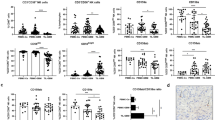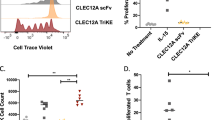Abstract
Relapse after allo-SCT in patients with acute leukaemia remains a major problem. A beneficial impact of alloreactive natural killer (NK) cells has been reported for myeloid malignancies, but has been questionable for B-lineage ALL. We analysed lysis of primary paediatric precursor-B-ALL blasts by 285 NK cell clones to investigate whether HLA class I expression on the blasts and phenotypic killer cell Ig-like receptor (KIR) expression on NK cells affect the lytic activity against ALL blasts. Precursor-B-ALL blasts with low HLA-I expression were lysed by a majority (79%) of NK cell clones, whereas those with high HLA-I expression showed low susceptibility to NK clones independent of their KIR expression patterns. NK cell activity against susceptible blasts was regulated by differential surface expression of the three major KIRs (CD158a, CD158b, CD158e). NK clones with none of these three KIRs or a single KIR that recognized no ligand, were not inhibited by the targets and exerted higher lysis (P=<0.0005) in comparison to NK clones expressing KIRs with a ligand on the ALL blasts. In conclusion, the quantity of HLA-I expression on precursor-B-ALL blast regulates overall NK cell susceptibility; in case of reduced HLA expression, differential surface expression of KIRs affects NK cell alloreactivity against those blasts.
This is a preview of subscription content, access via your institution
Access options
Subscribe to this journal
Receive 12 print issues and online access
$259.00 per year
only $21.58 per issue
Buy this article
- Purchase on Springer Link
- Instant access to full article PDF
Prices may be subject to local taxes which are calculated during checkout




Similar content being viewed by others
References
Green A, Clarke E, Hunt L, Canterbury A, Lankester A, Hale G et al. Children with acute lymphoblastic leukemia who receive T-cell-depleted HLA mismatched marrow allografts from unrelated donors have an increased incidence of primary graft failure but a similar overall transplant outcome. Blood 1999; 94: 2236–2246.
Godder KT, Hazlett LJ, Abhyankar SH, Chiang KY, Christiansen NP, Bridges KD et al. Partially mismatched related-donor bone marrow transplantation for pediatric patients with acute leukemia: younger donors and absence of peripheral blasts improve outcome. J Clin Oncol 2000; 18: 1856–1866.
Lang P, Handgretinger R, Niethammer D, Schlegel PG, Schumm M, Greil J et al. Transplantation of highly purified CD34+ progenitor cells from unrelated donors in pediatric leukemia. Blood 2003; 101: 1630–1636.
Bunin N, Carston M, Wall D, Adams R, Casper J, Kamani N et al. Unrelated marrow transplantation for children with acute lymphoblastic leukemia in second remission. Blood 2002; 99: 3151–3157.
Rocha V, Cornish J, Sievers EL, Filipovich A, Locatelli F, Peters C et al. Comparison of outcomes of unrelated bone marrow and umbilical cord blood transplants in children with acute leukemia. Blood 2001; 97: 2962–2971.
Oakhill A, Pamphilon DH, Potter MN, Steward CG, Goodman S, Green A et al. Unrelated donor bone marrow transplantation for children with relapsed acute lymphoblastic leukaemia in second complete remission. Br J Haematol 1996; 94: 574–578.
Moga E, Alvarez E, Canto E, Vidal S, Rodriguez-Sanchez JL, Sierra J et al. NK cells stimulated with IL-15 or CpG ODN enhance rituximab-dependent cellular cytotoxicity against B-cell lymphoma. Exp Hematol 2008; 36: 69–77.
Passweg JR, Tichelli A, Meyer-Monard S, Heim D, Stern M, Kuhne T et al. Purified donor NK-lymphocyte infusion to consolidate engraftment after haploidentical stem cell transplantation. Leukemia 2004; 18: 1835–1838.
Ruggeri L, Capanni M, Casucci M, Volpi I, Tosti A, Perruccio K et al. Role of natural killer cell alloreactivity in HLA-mismatched hematopoietic stem cell transplantation. Blood 1999; 94: 333–339.
Ruggeri L, Capanni M, Urbani E, Perruccio K, Shlomchik WD, Tosti A et al. Effectiveness of donor natural killer cell alloreactivity in mismatched hematopoietic transplants. Science 2002; 295: 2097–2100.
Pfeiffer M, Schumm M, Feuchtinger T, Dietz K, Handgretinger R, Lang P . Intensity of HLA class I expression and KIR-mismatch determine NK-cell mediated lysis of leukaemic blasts from children with acute lymphatic leukaemia. Br J Haematol 2007; 138: 97–100.
Valiante NM, Uhrberg M, Shilling HG, Lienert-Weidenbach K, Arnett KL, D'Andrea A et al. Functionally and structurally distinct NK cell receptor repertoires in the peripheral blood of two human donors. Immunity 1997; 7: 739–751.
Ciccone E, Pende D, Viale O, Di Donato C, Tripodi G, Orengo AM et al. Evidence of a natural killer (NK) cell repertoire for (allo) antigen recognition: definition of five distinct NK-determined allospecificities in humans. J Exp Med 1992; 175: 709–718.
Parham P . MHC class I molecules and KIRs in human history, health and survival. Nat Rev Immunol 2005; 5: 201–214.
Colonna M, Samaridis J . Cloning of immunoglobulin-superfamily members associated with HLA-C and HLA-B recognition by human natural killer cells. Science 1995; 268: 405–408.
Karre K . Immunology. A perfect mismatch. Science 2002; 295: 2029–2031.
Liao NS, Bix M, Zijlstra M, Jaenisch R, Raulet D . MHC class I deficiency: susceptibility to natural killer (NK) cells and impaired NK activity. Science 1991; 253: 199–202.
Ljunggren HG, Karre K . In search of the ‘missing self’: MHC molecules and NK cell recognition. Immunol Today 1990; 11: 237–244.
Sawicki MW, Dimasi N, Natarajan K, Wang J, Margulies DH, Mariuzza RA . Structural basis of MHC class I recognition by natural killer cell receptors. Immunol Rev 2001; 181: 52–65.
Lang P, Barbin K, Feuchtinger T, Greil J, Peipp M, Zunino SJ et al. Chimeric CD19 antibody mediates cytotoxic activity against leukemic blasts with effector cells from pediatric patients who received T-cell-depleted allografts. Blood 2004; 103: 3982–3985.
Leung W, Iyengar R, Turner V, Lang P, Bader P, Conn P et al. Determinants of antileukemia effects of allogeneic NK cells. J Immunol 2004; 172: 644–650.
Beelen DW, Ottinger HD, Ferencik S, Elmaagacli AH, Peceny R, Trenschel R et al. Genotypic inhibitory killer immunoglobulin-like receptor ligand incompatibility enhances the long-term antileukemic effect of unmodified allogeneic hematopoietic stem cell transplantation in patients with myeloid leukemias. Blood 2005; 105: 2594–2600.
Gagne K, Brizard G, Gueglio B, Milpied N, Herry P, Bonneville F et al. Relevance of KIR gene polymorphisms in bone marrow transplantation outcome. Hum Immunol 2002; 63: 271–280.
Giebel S, Locatelli F, Lamparelli T, Velardi A, Davies S, Frumento G et al. Survival advantage with KIR ligand incompatibility in hematopoietic stem cell transplantation from unrelated donors. Blood 2003; 102: 814–819.
Verheyden S, Bernier M, Demanet C . Identification of natural killer cell receptor phenotypes associated with leukemia. Leukemia 2004; 18: 2002–2007.
Verheyden S, Demanet C . Susceptibility to myeloid and lymphoid leukemia is mediated by distinct inhibitory KIR-HLA ligand interactions. Leukemia 2006; 20: 1437–1438.
Feuchtinger T, Schumm M, Weinstock C, Handgretinger R, Greil J, Niethammer D et al. Regeneration of KIR receptors on NK-cells in children after allogeneic stem cell transplantation: HLA independent predominance of CD158b. Bone Marrow Transplantation 2003; 31: S121.
Kim S, Poursine-Laurent J, Truscott SM, Lybarger L, Song YJ, Yang L et al. Licensing of natural killer cells by host major histocompatibility complex class I molecules. Nature 2005; 436: 709–713.
Fernandez NC, Treiner E, Vance RE, Jamieson AM, Lemieux S, Raulet DH . A subset of natural killer cells achieves self-tolerance without expressing inhibitory receptors specific for self-MHC molecules. Blood 2005; 105: 4416–4423.
Cooley S, Xiao F, Pitt M, Gleason M, McCullar V, Bergemann TL et al. A subpopulation of human peripheral blood NK cells that lacks inhibitory receptors for self-MHC is developmentally immature. Blood 2007; 110: 578–586.
Yu J, Heller G, Chewning J, Kim S, Yokoyama WM, Hsu KC . Hierarchy of the human natural killer cell response is determined by class and quantity of inhibitory receptors for self-HLA-B and HLA-C ligands. J Immunol 2007; 179: 5977–5989.
Acknowledgements
We thank A Barbarin-Dorner, L Koschnik for excellent technical assistance, A Velardi, L Ruggeri for helpful advice and D Martin for reviewing the manuscript. LCL with defined HLA-C expression was kindly provided by A Velardi, Perugia, Italy. This study was supported by a grant from the Deutsche Forschungsgemeinschaft (DFG) Grant no. 2001.048.1 (PL) and SFB685.
Author information
Authors and Affiliations
Corresponding author
Additional information
Declaration of commercial interest: All authors have no financial or commercial and personal interest or relationships to disclose with other people or organizations that could inappropriately influence or bias their work.
Rights and permissions
About this article
Cite this article
Feuchtinger, T., Pfeiffer, M., Pfaffle, A. et al. Cytolytic activity of NK cell clones against acute childhood precursor-B-cell leukaemia is influenced by HLA class I expression on blasts and the differential KIR phenotype of NK clones. Bone Marrow Transplant 43, 875–881 (2009). https://doi.org/10.1038/bmt.2008.398
Received:
Revised:
Accepted:
Published:
Issue Date:
DOI: https://doi.org/10.1038/bmt.2008.398
Keywords
This article is cited by
-
HLA-E expression constitutes a novel determinant for ALL disease monitoring following hematopoietic stem cell transplantation
Bone Marrow Transplantation (2021)



